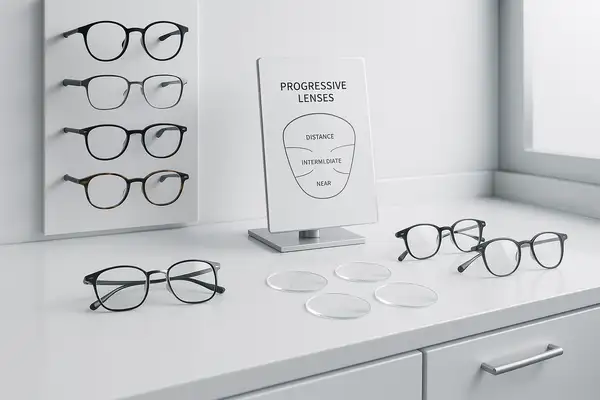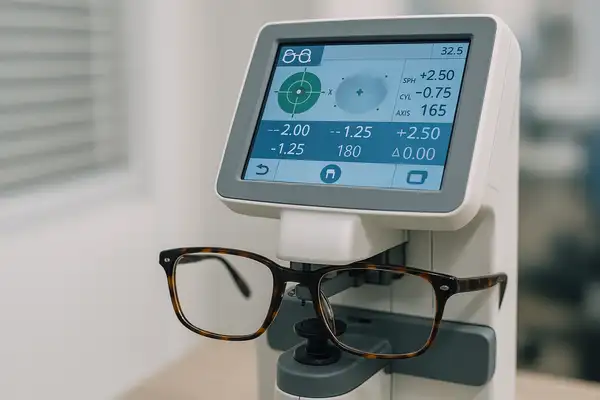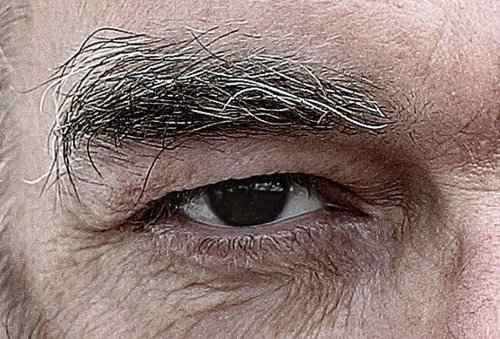Progressive lenses are multifocal eyeglass lenses designed to correct presbyopia—age-related difficulty focusing on close objects—without the visible line of bifocals or trifocals. Unlike older models, these lenses provide a smooth transition between different prescription strengths, offering clear vision at all distances.
Top 5 Brands of Progressive Lenses by Market Share (2024)
| Brand | Market Share (%) |
|---|---|
| Essilor | 36% |
| Zeiss | 22% |
| Hoya | 18% |
| Nikon | 12% |
| Rodenstock | 7% |
This chart highlights the top five brands of progressive lenses in 2024 by global market share. Essilor leads the market significantly, followed by Zeiss and Hoya. Nikon and Rodenstock hold smaller yet notable shares, reflecting a competitive landscape in premium vision correction solutions.
Think of them as the “automatic transmission” of eyeglasses. They do the shifting for you—from reading to driving to computer work—all in one sleek lens.
How Do Progressive Lenses Work?
Progressive lenses are engineered with multiple focal points:
- Distance vision at the top: This upper section of the lens is for viewing far-away objects like street signs while driving, watching a movie screen, or spotting a friend across a park. It helps keep distance scenes crisp and in focus.
- Intermediate (computer range) in the center: The middle portion handles mid-range vision, ideal for tasks like computer work, cooking, or reading a price tag while shopping. It covers distances around 20–30 inches (50–75 cm). Think of it as the “sweet spot” for daily multitasking.
- Near vision at the bottom: This lower part of the lens is meant for close-up tasks—reading books, knitting, texting on your phone, or checking your pill organizer. It works best at around 12–16 inches (30–40 cm). Unlike bifocals, the transition to this area is smooth and uninterrupted, reducing eye strain and offering a more natural reading experience.
Rather than separate sections, the power changes gradually. This gradient reduces the jarring “jump” that many people experience with bifocals.
Visual Zones Explained:
| Zone | Purpose | Common Use |
|---|---|---|
| Top | Distance | Driving, watching TV |
| Middle | Intermediate | Computer, cooking |
| Bottom | Near | Reading, smartphone use |
Who Needs Progressive Lenses?

Most people over the age of 40 develop presbyopia. Progressive lenses are ideal for:
- Adults with presbyopia: As people age, the natural lens in the eye becomes less flexible, making it harder to focus on nearby objects. Progressive lenses restore this lost near vision while also correcting distance, allowing adults over 40 to read, drive, and use screens without changing glasses.
- Individuals tired of switching between multiple glasses: Many people carry both reading glasses and distance glasses—and constantly swap between them. Progressive lenses eliminate this back-and-forth. One pair handles everything, streamlining daily routines and reducing the risk of forgetting or misplacing glasses.
- Professionals who need to see at varying distances throughout the day: Teachers, engineers, healthcare workers, and office employees often shift focus from screens to paperwork to people. Progressives allow seamless transitions without stopping to change eyewear. For example, a doctor can look at a chart, speak to a patient, and type notes—all without switching lenses.
Case Example: A 47-year-old woman from Austin, TX, reported significantly improved productivity at work after switching to progressive lenses, eliminating the need for two separate pairs of glasses.
Top Consumer Reasons for Choosing Progressive Lenses in 2024
| Reason | Percentage (%) |
|---|---|
| Convenience | 45% |
| Aesthetics (no bifocal line) | 25% |
| All-in-one vision correction | 18% |
| Doctor recommendation | 10% |
This chart shows the top reasons consumers chose progressive lenses in 2024. Convenience was the most cited factor, followed by aesthetic appeal and the benefit of all-in-one vision correction. Recommendations from doctors were also a notable influence, though less frequent.
Types of Progressive Lenses
There’s no one-size-fits-all. Progressive lenses vary in design and cost:
1. Standard Progressive Lenses
- Good for general use, especially for first-time progressive wearers
- Most affordable option, with prices typically ranging from $150–$250 (€140–€230)
- Narrow intermediate zone can make it harder to see clearly at computer distance
- Real-life scenario: A 49-year-old teacher from Denver found these lenses suitable for daily errands and reading, but struggled during long hours of computer work, leading to frequent head movements to find the right focus zone
2. Premium Progressive Lenses
- Offer significantly wider viewing zones, reducing the need for head tilts
- Advanced lens surfacing reduces peripheral distortion, leading to a more natural and comfortable visual experience
- Fully customizable based on lifestyle, posture, and even preferred reading distance
- Ideal for individuals who wear glasses all day and use them for varied tasks (driving, working, reading, etc.)
- Popular brands: Varilux X Series, Zeiss Individual 2
- Example: A 55-year-old architect from San Francisco described the switch to premium lenses as “game-changing,” citing seamless transitions between blueprints, screen work, and presentations without the typical strain
3. Office Progressive Lenses
- Specifically tailored for close-up and mid-range tasks (up to ~6 feet / 2 meters)
- Perfect for professionals who spend hours at a desk, such as writers, analysts, and designers
- Not recommended for outdoor or distance use—vision for faraway objects remains blurry
- Not a driving solution but ideal for indoor-focused lifestyles
- Example: A remote worker in Portland, OR, found these lenses drastically improved focus during long video calls and spreadsheet work, reporting a 60% drop in eye strain by the end of her workday
Diagnostics and Prescription Process
Getting the right progressive lenses starts with a comprehensive eye exam.
Diagnostic Tools and Accuracy:
| Method | Description | Accuracy (1–10) | Avg. Cost (USD) |
|---|---|---|---|
| Phoropter Test | Measures refractive error | 8 | $60–$120 |
| Digital Refraction | High-precision prescription via computer | 9 | $90–$160 |
| Wavefront Aberrometry | Customizes lenses using light waves | 10 | $150–$250 |
Some clinics use advanced fitting systems like Essilor’s Visioffice 3D, which maps how your eyes move with your head—super helpful for progressive lens fitting.

Advantages of Progressive Lenses
- No visible lines: With no sharp dividing lines like traditional bifocals, progressive lenses create a smoother, more youthful aesthetic. Users often report feeling more confident in meetings and social settings.
- Multi-distance clarity: Whether you’re checking your GPS, reading a menu, or working on a laptop, progressive lenses automatically support your focus at any distance. Before using them, users often switched between readers and distance glasses dozens of times daily—this back-and-forth disappears entirely.
- Long-term cost-effective: Instead of purchasing separate glasses for reading, computer use, and driving, one pair of progressive lenses covers all. Over a year or two, this not only simplifies life but saves money—especially for those who previously owned three or more pairs.
- Modern designs reduce distortion: Early progressives had harsh peripheral blurring, but current models like Varilux X and Zeiss Individual use advanced mapping and digital surfacing to minimize distortion. Users report much more stable vision when walking, climbing stairs, or scanning side to side.
Challenges and Adaptation
Not everyone takes to progressives overnight, and that’s completely normal. In fact, adapting to these lenses is a bit like learning to drive a new car—there’s a learning curve, but it becomes second nature with a little patience.
Common issues during the first few days:
- Initial dizziness or swim effect: This happens due to the changing lens powers as your eyes move. It’s disorienting at first but usually fades with consistent use.
- Slight peripheral blur: Unlike traditional lenses, progressives have softer edges that require your head to do more of the moving instead of just your eyes.
- Adjustment period: Typically 1–2 weeks, but some users need up to a month.
Successful Adaptation Practices:
- Wear them full-time from Day 1: Avoid switching back to your old glasses, even at home.
- Move your head, not just your eyes: Turn your head toward the object instead of glancing sideways.
- Start with simple environments: Try them at home before wearing them in a busy mall or while driving.
- Take short breaks if needed: If you feel strained, rest your eyes briefly, then put them back on.
- Clean lenses regularly: Smudges can interfere with your visual zones and make the adaptation harder.
Pro tip: Stick with it. Most users report a breakthrough moment—typically by the end of the first week—where suddenly everything clicks into place. Be patient and trust the process.
Cost Breakdown
The price of progressive lenses depends on customization and brand:
| Type | Average Cost (USD) | Cost (EUR) |
|---|---|---|
| Standard | $150–$250 | €140–€230 |
| Premium | $300–$800 | €280–€740 |
| Office Lenses | $200–$400 | €185–€370 |
Don’t forget to include lens coatings (anti-reflective, blue light blocking), which can add $50–$150.
Average Cost of Progressive Lenses by Country (2024)
This horizontal bar chart compares the average cost of progressive lenses across five countries in 2024. The USA tops the list with an average cost of $350, while India offers the most affordable option at $120. European countries fall in the mid-range, reflecting regional pricing trends in optical healthcare.
Real-Life Experiences from the U.S.
- Male, 52, Chicago, IL: Initially skeptical, he found the first couple of days mildly disorienting—comparing the sensation to “walking on a moving walkway that no one else sees.” However, by day five, the adaptation clicked. He now wears his progressive lenses for every activity—”even grilling on the patio while checking scores on my phone.”
- Female, 45, Miami, FL: After years of switching between reading glasses and distance glasses, she opted for Zeiss Individual 2 on the recommendation of her optometrist. “The difference in clarity was like switching from VHS to HD,” she said. However, she strongly advises others to avoid self-fitting kits online, as her initial DIY attempt led to severe headaches and return shipping nightmares.
Editorial Advice
Reyus Mammadli, healthcare advisor, recommends progressive lenses for anyone juggling multiple visual tasks daily. “Today’s lenses are smart—almost like AI for your eyes. But professional fitting and premium lens design are key to success.”
If you’re tired of juggling readers and distance glasses, or just want a sleeker look without sacrificing clarity, it’s time to upgrade.
Choose lenses tailored to your lifestyle, not just your budget. And give yourself time to adjust—your eyes (and brain) will thank you.
References
- American Academy of Ophthalmology. “What Are Progressive Lenses?” — https://www.aao.org/eye-health/glasses-contacts/progressive-lenses
- Mayo Clinic. “Presbyopia: Symptoms and Causes” — https://www.mayoclinic.org/diseases-conditions/presbyopia/symptoms-causes
- Essilor USA. “Visioffice® 3: Personalized Lens Measurement” — https://www.essilorusa.com/products/visioffice
- Zeiss Vision Care. “ZEISS Progressive Individual 2” — https://www.zeiss.com/vision-care/int/products/lenses/progressive-lenses/individual-2.html
- Varilux Lenses by Essilor. “Varilux X Series: See Clearly at Every Distance” — https://www.variluxusa.com/lenses/varilux-x-series
- All About Vision. “Progressive Lenses: What You Need to Know” — https://www.allaboutvision.com/lenses/progressive.htm
- Vision Council of America. “Digital Eye Strain & Lens Solutions” — https://thevisioncouncil.org/research/digital-eye-strain
- Cleveland Clinic. “Bifocals vs. Progressive Lenses” — https://health.clevelandclinic.org/bifocals-vs-progressive-lenses/
- Journal of Optometry. “Wavefront Technology in Progressive Lens Design” — https://www.sciencedirect.com/science/article/pii/S1888429619300970
- U.S. Bureau of Labor Statistics. “Occupation Visual Demands” — https://www.bls.gov/





